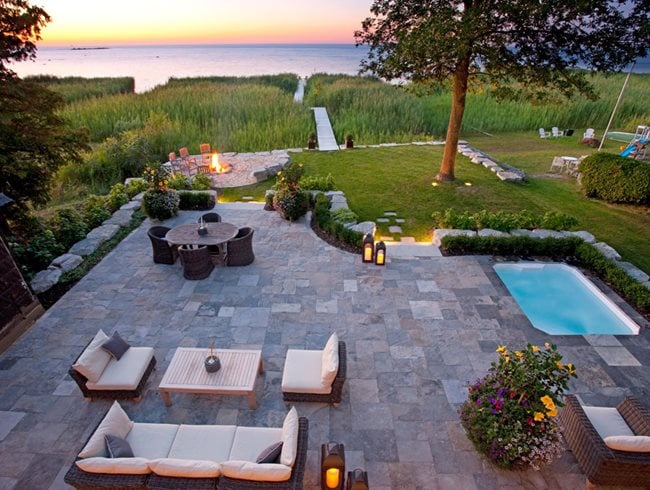12 TIPS FOR DESIGNING YOUR IDEAL OUTDOOR LIVING SPACE
Expert advice for creating an outdoor living area you’ll loveAs temperatures rise, our thoughts turn to outdoor living. Blooming flowers and the smell of backyard barbecues lure us out onto the porch or patio with friends and family. Learn how to create your ideal outdoor living space with help from these 12 tips.

The spectacular view can be seen from several gathering spots in this multifunctional outdoor space. Photo by: Derek Trask / Alamy Stock Photo.
1. Purpose: Think about how the outdoor space will be used and plan accordingly.
- Do you host dinner parties or BBQs?
- How many guests do you typically entertain?
- Are you looking for a quiet space to relax and unwind?
- Does your space need to be kid or pet friendly with a separate area just for them?
2. Layout: When designing an outdoor space, landscape architect, David Pfeiffer suggests using the same thoughtfulness as if you were designing the floor plan of a new house. Each outdoor area should have a logical and functional connection to the inside of the house, like locating the outdoor dining area near the kitchen.
3. Surroundings: Make the most of the views your property has to offer — arrange a small sitting area to enjoy a cup of coffee and watch the sunrise or a table and chairs for hors d’oeuvres and cocktails at sunset. Likewise, use hedges or screens to block out unsightly eyesores. Matthew Cunningham, landscape architect, suggests looking beyond the boundaries of a property to observe how the site fits into its surrounding environment.

A pergola provides an escape from hot, overhead summer sun. The curtains offer additional protection from sun and wind. Photo by: Spring_summer / Shutterstock.
4. Exposure: Which direction your outdoor space faces can define its functionality. In the mountains of Central Idaho, landscape ecologist and designer, Kelley Weston, had to consider the fact that north- and east-facing spaces are unusable in winter and can even be too chilly for comfort in summer.
5. Wind Patterns: Make note of prevailing wind direction and time of day. Some areas may be calm in the morning but have a regular evening breeze. The last thing you want is to build a fire pit area and have the seating be down wind or design a beautiful outdoor dining area in a wind tunnel.
6. Comfort: If your outdoor space gets a lot of afternoon or early-evening sun, you’ll want to provide shade for comfort. Umbrellas, pergolas, covered patios, or trees can take the edge off on a hot summer day by providing shelter from the heat, as well as provide shelter from a passing summer shower.

The hardscape area on this patio provides ample surface for seating and dining areas, while the surrounding greenery softens the space. Photo by: Paul Saini / Shutterstock.
7. Hardscape: Weston suggests using a combination of surfaces, with a portion of the ground soft and inviting, yet leaving enough hard surface for chairs and other furniture. He prefers natural elements and incorporating flagstone, decomposed granite, large boulders and wood decking.
8. Plant Selection: Even an avid gardener needs a place to relax. Choose easy-care greenery in and around your outdoor living space for a low-maintenance area. Shirley Watts, designer and builder, says her ideal plants are nice, rounded shrubs that grow about 4 inches a year; like boxwoods, agaves, and aloes for her California climate. (See more easy-care shrubs.) She also likes to use vertical surfaces to design green walls for privacy and leave overhead space open to see the sky. Also keep in mind, that while plants that attract bees and other pollinators are a good thing in your garden, you might not want those particular plants in the middle of your dining area. For more insight into plant selection, see Planting Ideas for Your Garden.
9. Furnishings: Appropriate outdoor furniture choices will depend on the intended use of the space — dining, relaxing, entertaining — or most likely, some combination of all three. Select furniture that is comfortable and practical for outdoor use, weather resistant and washable. Pfeiffer recommends small movable tables for cocktails and snacks. Use colors and patterns to bring your interior style outside.

Enjoy both fire and water in this area that includes a fountain as well as a fire pit, along with nearby seating. Photo by: Breadmaker / Shutterstock.
10. Water: For a refreshing and relaxing addition to your space, consider adding a water feature. It doesn’t need to be an elaborate fountain or waterfall, as according to Weston, just the suggestion of water, even a trickle, can have an impact. The sight and sound of flowing water have been shown to enhance relaxation and even lower blood pressure. If you’re lucky enough to be near a natural source of water — a lake, the ocean, or a babbling brook — consider designing an outdoor living area that takes advantage of what nature has provided.
11. Fire: When evenings are cool, don’t move the party inside. Extend your outdoor entertaining season by creating a fire pit or fireplace area with comfortable seating. Enjoy evenings being warmed by the fire year-round in milder climates. Incorporate storage areas for blankets and marshmallow-roasting supplies. Find more inspiration to warm your outdoor space in Fire Features.
12. Lighting: Make your outdoor space a true extension of your home by incorporating lighting. Illuminate outdoor cooking areas to allow more meal prep to be done outside. Create visual interest and expand the feel of the space by up-lighting trees or fencing farther out in the yard. For safety, add decorative lighting to brighten steps and pathways. See Light Up Your Landscape for more ideas on how to include lighting in your outdoor design.
When you purchase products through links on our site, we may receive an affiliate commission. Thank you for your support.
